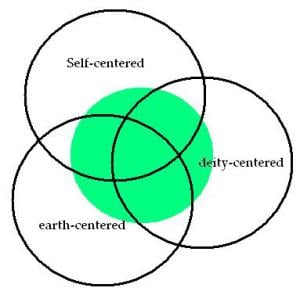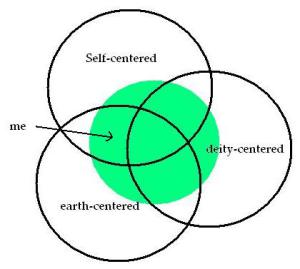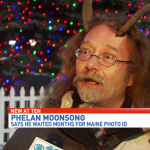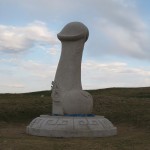This post is part 2 of a 3-part series. In the first part, I discussed how I had come to realize the ego-centrism of my earlier view of the Pagan community.
Celebrating Nature, Working Magic, and Honoring Deities
Imagine that the Pagan community has not one, but multiple “centers”. Imagine each of these “centers” defines Pagan identity and authenticity differently. To begin with there is what I will call “earth-centered Paganism”. I realize this is a problematic term, because “earth” is a cultural construct and means different things to different people, but it remains a useful category, I think. Earth-centered Paganism would include those Paganisms concerned primarily with ecology, those more local forms of Paganism that I would call “backyard Paganism” or are sometimes called “dirt worship”, and many forms of (neo-)animism which view humans as non-privileged part of an interconnected more-than-human community of beings. The Pagan identity of earth-centered Pagans is defined by their relationship to their natural environment. Authenticity for these Pagans is defined by one’s ability to connect with the more-than-human world. Of course, there are many whose spirituality might be called “earth-centered” by this definition, but who reject the label “Pagan”. Some of the rejection of the Pagan label by those who might otherwise be called Pagan is due to the association of the label with the other two groups (with whom they do not identify).
The second group is what I will call the “Self-centered” Paganism. I don’t mean this in the pejorative sense of ego-centrism, and for that reason I have capitalized the word “Self”, by which I mean something which transcends the ego and even the individual. This analogy may be helpful: as the Vedantic Brahman is to the Atman, so the Self is to the ego. “Self” can be a misleading term, but I think it is actually appropriate for that reason, because the danger of Self-centered spiritual practice is always that it will become ego-centered. (My own spiritual path partially overlaps with this kind of Paganism.) Self-centered Paganism includes Jungian Neopaganism, many forms of Wicca and feminist witchcraft, and more ceremonial or esoteric forms of Paganism. The Pagan identity of Self-centered Pagans is defined by spiritual practices which aim at development of the individual, spiritually or psychologically. Paganism is, for some Self-centered Pagans, a form of therapy or self-help. Authenticity is determined by one’s relationship with one’s Self, with that larger sense of Self which extends beyond the boundaries of one’s ego and one’s individual person. To put it another way, Pagan authenticity for this group is measured in terms of personal growth, whether that growth be toward psychological wholeness or ecstatic union with a divine “One”. As with the earth-centered category, there will be many whose spiritual path might be described as Self-centered, but who do not identify as Pagan. This would include many ceremonial magicians, as well as a large segment of those who practice various “New Age” spiritualities. For some reason, this group seems to have the broadest or least-exclusive sense of what Paganism is.
The third group is “deity-centered” Paganism, a term which I adopted from Janet Farrar and Gavin Bone’s book Progressive Witchcraft. Deity-centered Paganism includes many forms of polytheistic worship, many Reconstructionist or Revivalist forms of Paganism, including those which are closer to Heathenry, and those which borrow techniques (i.e., aspecting) from African-diasporic religions. The Pagan identity of deity-centered Pagans is defined by a dedication to one or more deities. Authenticity is determined by one’s relationship with those deities and/or one’s relationship with the reconstructed practices of ancient pagans who worshiped those deities. As with the other two categories mentioned above, there will be many people whose spirituality might be called “deity-centered”, but who do not identify as Pagan. They would include some polytheists who have rejected the Pagan label, many traditional or indigenous (small-p) “pagan” religions, and actually the Judeo-Christian-Islamic monotheisms as well. Again, the reason why some deity-centered polytheists reject the Pagan label may be because they associate the term with one or both of the other groups mentioned above (with whom they do not identify).

In the image above, the green shaded area represents Paganism. (Note, the overlapping area of the three centers is not intended to imply a central or “core” Paganism.)
These three groups correspond to three chapters in Graham Harvey’s book, What Pagans Believe, which describe Pagan practices: “Celebrating Nature”, “Working Magic”, and “Honoring Deities”. Of course, there will be some overlap between these groups. Some “Goddess-centered” forms of Pagan worship might overlap with both deity-centered and Self-centered Paganisms, and maybe also earth-centered Paganism. Some more literalist forms of animism, which might be called “spirit-centered”, might overlap with both earth-centered and deity-centered Paganism.
My own Paganism, overlaps with both earth-centered and Self-centered Paganism. I am coming to realize that my own spiritual path is not as unified as I thought. I feel drawn toward both these forms of Paganism. And while there are ways to reconcile each of these “centers”, there is also a certain amount of tension between them. Reconciling those two “centers” is one of the goals I have for this blog, but one which I admit I have not given much attention to up to this point.
Take a recent online discussion I participated in about the personification of deities. I found myself defending personification of the gods to Pagans who I think would tend to fall into the earth-centered category. This was somewhat ironic, I realized, because I do not personify natural phenomena (“the gods without”). But I do personify those archetypal forces within myself (“the gods within”). When I was defending personification, I was speaking primarily from the perspective of a Self-centered Pagan — but I was speaking to earth-centered Pagans. Personification of gods, I realize now, means very different things to these two different groups — and it means something else to deity-centered Pagans. And this is just one topic. Gods, spirit, magic, re-enchantment, connectedness, worship: these are just a few examples of concepts which would mean very different things to each group.
Three Classical Paganisms
It is curious that these three groups would ever have come together under one “Pagan umbrella”. Part of it is historical accident. But I also think that it has something to do with how the word “pagan” has been used to mean different things before the Neopagan revival of the mid-20th century. It is interesting, for example, that these three groups correspond roughly to three different “paganisms” that were written about a century ago by classicists and students of philology. When writers talked about “paganism”, they almost always meant Classical, or Greco-Roman, paganism. But different writers had different ideas of what Classical paganism was.
Some authors tended to emphasize the paganism of the poets and the state cults. This was the paganism of pantheon, the twelve Olympian deities we are familiar with, and writers like Homer and Virgil. This form of Classical paganism corresponds to the deity-centered Paganism of today. (The view of Classical paganism from the perspective of the poets is the one most people are familiar with. Bulfinch’s Mythology, Edith Hamilton’s Mythology, and Robert Graves’ The Greek Myths are all representative. The focus on the state cults and the Olympian gods among academics can be seen in Lewis Richard Farnell’s five-volume The Cults of the Greek States.)
Other classicists tended to elevate the mystery religions over the Olympian cult as paganism par excellence. For them, the Eleusinian or Dionysian mystery cults were in some sense morally superior to the religion of the state and the gods of Olympian myth. Many such writers treated the mystery religions as an intermediate phase between paganism and Christianity because the mysteries were also concerned with personal salvation. This form of Classical paganism corresponds to the Self-centered Paganism of today. (Nietzsche is often misinterpreted as elevating the Dionysiac mysteries over those of the Olympians, of whom Apollo was representative, in his book The Birth of Tragedy. Jane Ellen Harrison elevates the mystery religions of the Greeks above the worship of the Olympian gods in her book, Themis.)
Still other academics believed that true paganism was to be found neither in the myths of the poets, nor the state cults of the Olympians, nor the ancient mystery religions, but rather, in the local cults of the simple folk of the countryside. They believed that the worship of these people tended more toward animism than polytheism. Rather than personal deities, they worshiped the landscape around them. This “folk religion” is the most difficult to reconstruct because it left neither written record nor architectural monuments. This form of Classical paganism corresponds to contemporary earth-centered Paganism. (Jane Ellen Harrison also elevates the aniconic worship of chthonian nature spirits above the worship of the Olympian gods in her book, Themis. For more on Classical folk religion, check out Martin Nilsson’s Greek Folk Religion and Jon Mikalson’s Athenian Popular Religion. A good discussion of the difficulties of reconstructing “folk religion” outside of the Classical context can be found in William Dever’s Did God Have a Wife: Archaeology and Folk Religion in Ancient Israel.)
I said above that the remarkable congregation of earth-centered, Self-centered, and deity-centered Pagans under one “umbrella” may have something to do with how the word “pagan” has been used differently even before the Neopagan revival of the mid-20th century. Graham Harvey observed this in his book What Pagans Believe. He writes, “The shifts in the meaning of the word ‘Pagan’ match trends within the [Neo-]Pagan religion.” When earth-centered practitioners identify with the Pagan label, it is often the pagans of the countryside (the “folk”) that they imagine, the people who worshiped the gods of the landscape where they lived, in contrast to the cosmopolitan gods of the city-states. Harvey writes:
“[The] emphasis on the original meaning of ‘Pagan’ — ‘as an inhabitant of a particular place’ — has encouraged a new focus on locality in modern paganism. A classical pagan was someone who belonged, some one who celebrated where they lived, someone who knew their local shrines, springs, hills, trees and neighbors, and could trace their decent from local ancestors.”
In contrast, when Self-centered practitioners identify with the Pagan label, it is often with the participants in the ancient pagan mysteries that they identify. In fact, many attempt to draw historical and conceptual links between the Classical mysteries and their present-day rituals. In Witchcraft Today, Gerald Gardnerdevotes a chapter to drawing connections between witchcraft and the ancient mysteries. Or consider Vivianne Crowley’s essay, “Wicca as a Modern-Day Mystery Religion”, where she writes that “the approach to the Self is made through an external expression of the inner psychological process–religious ritual”. Jung, who is so influential among Self-centered Pagans, was particularly interested in the Mithraic mysteries, and Richard Noll makes the claim the Jung’s philosophy was an attempt to revive the mystery cult with himself as its object.
Finally, when deity-centered practitioners identify with the Pagan label, it is often with the worshipers of the more well-known gods and goddesses of the poets and the state cults that they identify. The reason for this may be purely practical. In order to reconstruct an ancient pagan religion, one must have sources. Folk religions leave little trace and the mysteries were largely secret. In contrast, the gods of the poets and the state were well-documented, both in literature and in epigraph.
Three Pagan Reactions to Monotheism
The term “pagan” has also been used historically to mean “non-Christian”. To a certain extent, I think it can be argued that contemporary Paganism is a reaction to Christianity, or more accurately, Judeo-Christian-Islamic monotheism. But, to the extent that this is true, I think each one of the three “centers” reacts differently to JCI-monotheism. For example, earth-centered Pagans reject the “other-worldly” focus of JCI eschatology and the dualistic separation of matter and spirit. They reject the transcendent conception of divinity and the notion that nature is fallen. And they also reject the anthropocentrism of the JCI narrative. Self-centered Pagans, on the other hand, reject the JCI condemnation of the body, of sex, and of the feminine. The seek to reclaim all those aspects of the Self that have been repressed by JCI morality. Finally, deity-centered Pagans, who value pluralism, reject monotheism and all it implies, including the notion that there is only one path to the divine.
Conclusion
For me, this tri-centered model helps to explain much of the identity crisis which is haunting contemporary Paganism. When some people decide to step out from under the Pagan umbrella, I don’t believe it is because of snobbery. Rather, it is because of a perception that the term “Pagan” is associated with one or two of the other groups with whom they do not identify. Thus, polytheistic deity-centered practitioners may discard the Pagan label because it is associated with Self-centered forms of Wicca, while earth-centered animists may reject the Pagan label because it is associated with deity-centered polytheism. For some reason that I haven’t figured out yet, it seems the Self-centered group is less likely to use the Pagan label in these exclusivist ways.

I also feel this is a truer representation of the Pagan community than my previous models because it does not privilege my own brand of Paganism — or any single form of Paganism for that matter. I suspect that most self-identified Pagans could find themselves comfortably somewhere within this scheme. Finally, this model helps me to explain my own divided Pagan identity — how I feel kinship with some Pagans (Self-centered and earth-centered), but not others (deity-centered), and how I feel my spiritual focus divided between two centers that may or may not be reconcilable. But that is the subject for part 3 of this series.















